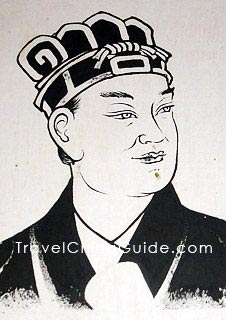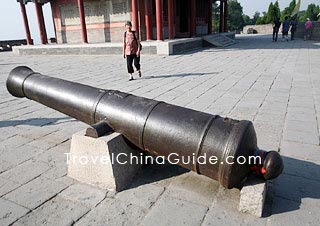Four Great Inventions of Ancient China
Paper Making
 |
| Cai Lun, inventor of papermaking |
The invention of paper greatly contributed to the spread and development of civilization. Before its invention, bones, tortoise shells, and bamboo slips were all used as writing surfaces, but as Chinese civilization developed they proved themselves unsuitable because of their bulk and weight. Hemp fiber and silk were used to make paper but the quality was far from satisfactory. Besides, these two materials could be better used for other purposes so it was not practical to make paper from them.
Xue fu wu che is a Chinese idiom describing a learned man. The story behind it concerns a scholar named Hui Shi who lived during the Warring States Period. He needed five carts to carry his books when he traveled around teaching. Books at that time were made of wood or bamboo slips so they were heavy and occupied a lot of space. Reading at the time needed not only brainwork but also physical strength.
In 105 A.D. Cai Lun, a eunuch during the Eastern Han Dynasty, invented paper from worn fishnet, bark and cloth. These raw materials could be easily found at a much lower cost so large quantities of paper could be produced.
The making technique was exported to Korea in 384 A.D. A Korean Monk then took this skill with him to Japan in 610 A.D.
During a war between the Tang Dynasty and the Arab Empire, the Arabs captured some Tang soldiers and paper making workers. Thus, a paper factory was set up by the Arabs.
In the 11th Century the skill was carried to India when Chinese monks journeyed there in search of Buddhist sutras.
Through the Arabs, Africans and Europeans then mastered the skill. The first paper factory in Europe was set up in Spain. In the latter half of the 16th century, this skill was brought to America. By the 19th century, when paper factories were set up in Australia, paper making had spread to the whole world.
Cai Lun, also known as Tsai Lun, was listed in the book The 100: A Ranking of the Most Influential Persons in History by Michael H. Hart.
Gunpowder
 |
| Cannon |
In the 12th and 13th centuries, gunpowder spread to the Arab countries, then Greece, other European countries, and finally all over the world.
Printing Technique
Inspired by engraved name seals, Chinese people invented fixed-type engraved printing around 600 A.D. The skill played an important role in the Song Dynasty but its shortcomings were apparent. It was time-consuming to engrave a model, not easy to store, and not easy to revise errors.
During the reign of Emperor Ren Zong of the Northern Song Dynasty, Bi Sheng invented moveable, reusable clay type after numerous tests. Single types were made and picked out for printing certain books. These types could be used again and again for different books. Because of the large number of different characters in the Chinese written language, this technique did not have a dramatic impact at the time. However, today, this typesetting technique is regarded as a revolution in the industry. About 200 years later, this moveable-type technique spread to other countries and advanced the development of world civilization.
Compass
During the Warring States period, a device called a Si Nan became the forerunner of the compass. A Si Nan was a ladle-like magnet on a plate with the handle of the ladle pointing to the south. In the 11th century, tiny needles made of magnetized steel were invented. One end of the needle points north while the other points south. The compass was thus created. The compass greatly improved a ship's ability to navigate over long distances. It was not until the beginning of the 14th century that compass was introduced to Europe from China.